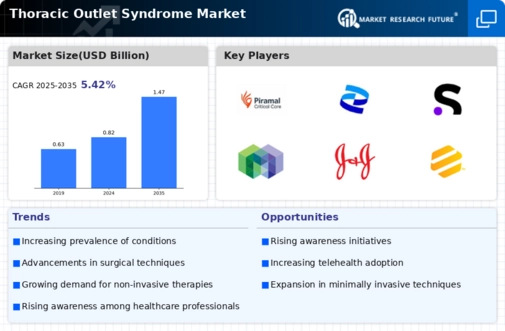Market Growth Projections
The Global Thoracic Outlet Syndrome Market Industry is expected to experience substantial growth over the coming years. Projections indicate that the market will reach 0.82 USD Billion in 2024 and is anticipated to grow to 1.47 USD Billion by 2035. This growth is underpinned by a compound annual growth rate of 5.42% from 2025 to 2035. Such figures suggest a robust demand for diagnostic and therapeutic solutions, driven by factors such as increasing prevalence, advancements in treatment options, and a growing awareness of TOS among healthcare providers and patients alike.
Rising Geriatric Population
The increasing geriatric population is a significant driver of the Global Thoracic Outlet Syndrome Market Industry. Older adults are more susceptible to musculoskeletal disorders, including TOS, due to age-related changes in anatomy and physiology. As the global population ages, the demand for effective management of TOS is likely to rise, leading to greater market opportunities. This demographic shift may contribute to the market's growth trajectory, with projections indicating a value of 0.82 USD Billion in 2024. Addressing the needs of this population will be crucial for healthcare systems worldwide.
Expansion of Treatment Options
The expansion of treatment modalities for Thoracic Outlet Syndrome is influencing the Global Thoracic Outlet Syndrome Market Industry. A variety of therapeutic approaches, including physical therapy, medication, and surgical interventions, are now available to address TOS effectively. This diversification allows healthcare providers to tailor treatments to individual patient needs, enhancing overall outcomes. As new therapies emerge and existing ones are refined, the market is poised for growth, with an expected increase to 1.47 USD Billion by 2035. The ongoing research into innovative treatments may further bolster this expansion.
Growing Awareness and Education
The heightened awareness surrounding Thoracic Outlet Syndrome is a crucial factor driving the Global Thoracic Outlet Syndrome Market Industry. Educational initiatives aimed at both healthcare professionals and the general public are essential for recognizing the symptoms and understanding the implications of TOS. As awareness increases, more patients are likely to seek medical advice, leading to higher diagnosis rates and subsequent treatment. This trend may contribute to the market's anticipated growth, with a compound annual growth rate of 5.42% projected from 2025 to 2035, reflecting the ongoing commitment to improving TOS management.
Advancements in Diagnostic Techniques
Technological innovations in diagnostic methods are significantly influencing the Global Thoracic Outlet Syndrome Market Industry. Enhanced imaging techniques, such as MRI and ultrasound, facilitate accurate identification of TOS, enabling timely treatment. These advancements not only improve patient outcomes but also increase the efficiency of healthcare systems. As diagnostic capabilities expand, the market is expected to grow, with projections indicating a rise to 1.47 USD Billion by 2035. The integration of artificial intelligence in imaging analysis may further streamline the diagnostic process, potentially leading to a more precise understanding of TOS.
Increasing Prevalence of Thoracic Outlet Syndrome
The rising incidence of Thoracic Outlet Syndrome (TOS) is a primary driver for the Global Thoracic Outlet Syndrome Market Industry. Factors such as sedentary lifestyles and increased participation in sports contribute to this trend. As more individuals experience symptoms related to TOS, healthcare providers are likely to seek effective treatment options. The market is projected to reach 0.82 USD Billion in 2024, reflecting the growing demand for diagnostic and therapeutic solutions. This increase in prevalence underscores the need for awareness and education regarding TOS, potentially leading to earlier diagnosis and intervention.

















Leave a Comment